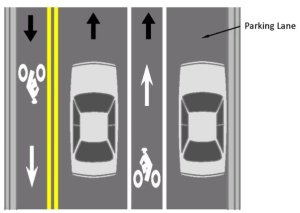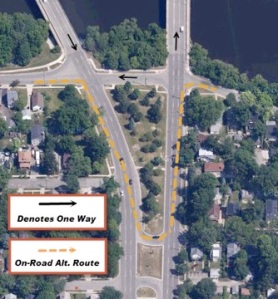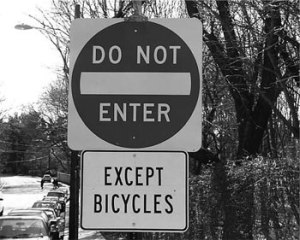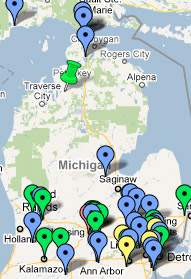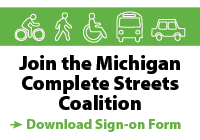You are currently browsing the tag archive for the ‘contra-flow’ tag.
This post continues an ongoing blog series highlighting various complete street elements, their benefits, and use in Michigan communities. Check back often to catch future posts, and keep a lookout for contra-flow bike lanes in your community!
What are Contra-flow Bike Lanes? Contra-flow bike lanes allow legal bicycle access to riders wishing to bike in the opposite direction of traffic flow on one-way streets, creating two-way bicycle access on a one-way street. Contra-flow lanes are placed on the right side of a one-way street (from a bicyclist’s perspective traveling against traffic; from a motorist’s perspective, the lane would be on his or her left). A double-yellow line separates the contra-flow lane from traffic. Because the lanes take bicyclists in the opposite direction of traffic, signage plays an integral role in maintaining safety. “Do Not Enter” and “Bikes Only” signs should be placed at intersections to ensure vehicles do not travel the wrong way.
Why Use Contra-flow Bike Lanes? Contra-flow bike lanes increase connectivity for bicyclists and reduce dangerous wrong-way riding on one-way streets. A great example of how contra-flow lanes accomplish these goals is MDOT’s Martin Luther King/M-99 contra-flow lane. Josh DeBruyn, MDOT Bicycle and Pedestrian Coordinator, reports that prior to installation “cyclists would either cross the road illegally, transition to sidewalk, or travel nearly 10 times the distance while navigating 6 lanes of traffic to make a “Michigan left” to avoid the one-way street, when in reality the bicyclists simply wants to travel straight 150 feet.” In the right situation, contra-flow lanes can be extremely beneficial.
When to Use Contra-flow Bike Lanes: The appropriateness of contra-flow lanes is dependent on bicycling traffic volumes, incidences of wrong-way riding, nearby destinations, vehicle traffic volumes, and road characteristics. The National Association of City Transportation Officials (NACTO) lists several scenarios where contra-flow lanes may be appropriate:
- On streets where large numbers of bicyclists are already riding the wrong way.
- On corridors where alternate routes require excessive out-of-direction travel.
- On corridors where alternate routes include unsafe or uncomfortable streets with high traffic volumes and/or no bicycle facilities.
- On corridors where the contra-flow lane provides direct access to destinations on the street under consideration.
- Where two-way connections between bicycle facilities are needed along one-way streets.
- Work best on low-speed, low volume streets to minimize the risk of dangerous crashes.
Because contra-flow lanes are counterintuitive to drivers, education and outreach efforts are vitally important at the time of installation. Extra signage at driveways and minor intersections will help improve safety. Installing “No Turn On Red” signs at signal-controlled intersections is recommended by NACTO, and would increase safety for bicyclists where drivers make left turns.
Safety Benefits: Because contra-flow lanes formalize wrong-way riding on one way streets, drivers are better notified of bicyclists’ presence. Contra-flow lanes also allow bicyclists to avoid high-traffic detours, where crossing over multiple lanes poses a significant safety risk.
What Drivers Should Know: Drivers should expect to encounter bicyclists in both directions. When making left-hand turns, drivers need to make sure the contra-lane is clear of bicyclist traffic. Passing other drivers in contra-lanes is prohibited, and drivers should be careful not to cross the double-yellow lines.
Cost Considerations: Installation of contra-flow bike lanes should be done in conjunction with road resurfacing, where possible, to reduce costs. Costs will vary greatly depending on the length of the proposed bike lane and the extent of signage needed.
Contra-flow bike lanes are relatively new in Michigan. The Martin Luther King/M-99 contra lane was the first one put in by MDOT. If you have a contra-flow bike lane in your community, please Let us know!
Check out these resources for more information:
NACTO Guidance on Contra-flow Bike Lanes
Federal Highway Administration Guidance
Biking in Bloomington, IN: Contra-flow Lanes
Next Topic: Mid-Block Pedestrian Islands Explained
Previous Topic: Pedestrian Hybrid Beacons (HAWK Signals) Explained

